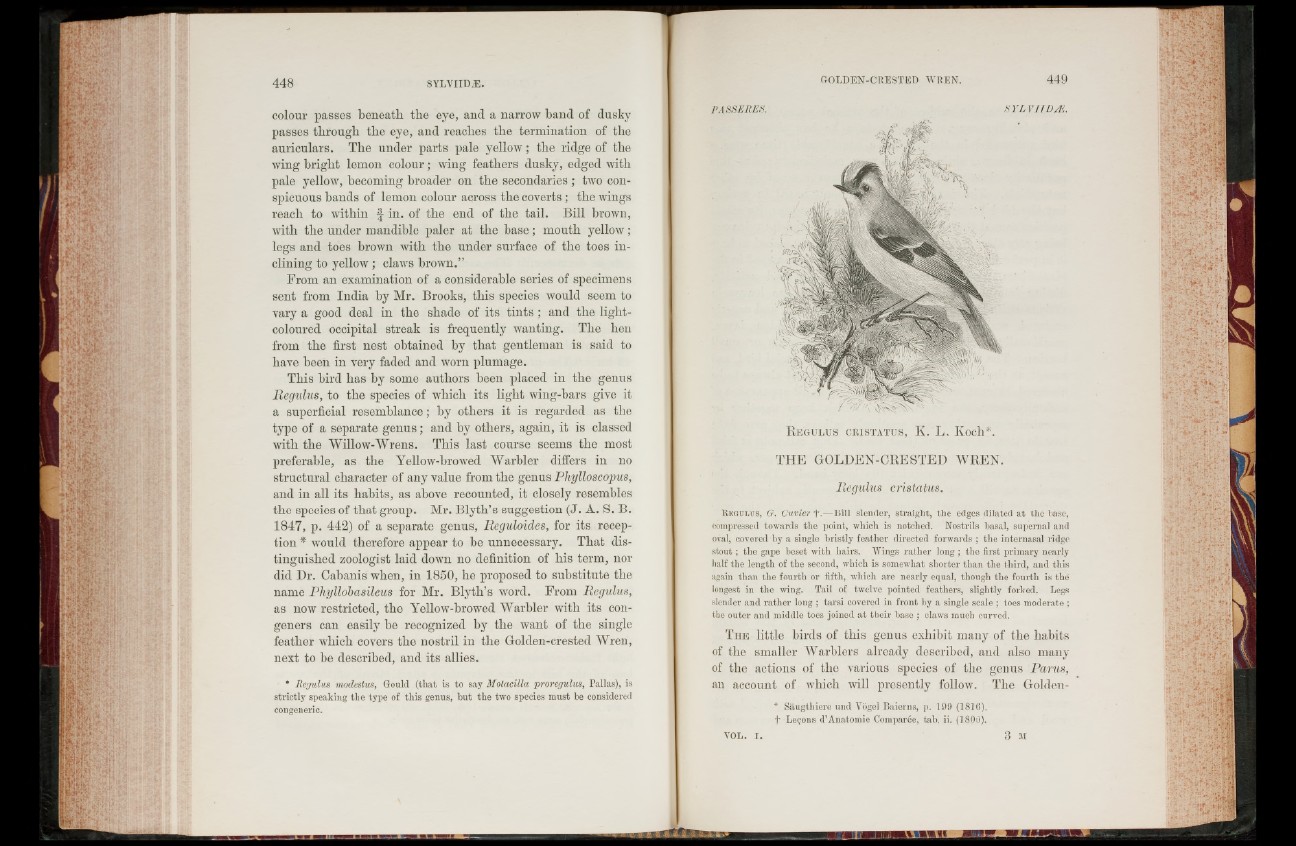
colour passes beneath the eye, and a narrow hand of dusky
passes through the eye, and reaches the termination of the
auriculars. The under parts pale yellow; the ridge of the
wing bright lemon colour; wing feathers dusky, edged with
pale yellow, becoming broader on the secondaries; two conspicuous
bands of lemon colour across the coverts; the wings
reach to within § in. of the end of the tail. Bill brown,
with the under mandible paler at the base; mouth yellow;
legs and toes brown with the under surface of the toes inclining
to yellow ; claws brown.”
From an examination of a considerable series of specimens
sent from India by Mr. Brooks, this species would seem to
vary a good deal in the shade of its tin t s ; and the light-
coloured occipital streak is frequently wanting. The hen
from the first nest obtained by that gentleman is said to
have been in very faded and worn plumage.
This bird has by some authors been placed in the genus
liegulus, to the species of which its light wing-bars give it
a superficial resemblance; by others it is regarded as the
type of a separate genus; and by others, again, it is classed
with the Willow-Wrens. This last course seems the most
preferable, as the Yellow-browed Warbler differs in no
structural character of any value from the genus Phylloscopus,
and in all its habits, as above recounted, it closely resembles
the species of that group. Mr. Blyth’s suggestion (J. A. S. B.
1847, p. 442) of a separate genus, Reguloides, for its reception
* would therefore appear to be unnecessary. That distinguished
zoologist laid down no definition of his term, nor
did Dr. Cabanis when, in 1850, he proposed to substitute the
name Phyllobasileus for Mr. Blyth’s word. From liegulus,
as now restricted, the Yellow-browed Warbler with its congeners
can easily be recognized by the want of the single
feather which covers the nostril in the Golden-crested Wren,
next to be described, and its allies.
* Reyulus modestus, Gould (that is to say Molacilla proregulus, Pallas), is
strictly speaking the type of this genus, but the two species must be considered
congeneric.
R e g u l u s c r is t a t u s , K. L, Koch*.
THE GOLDEN-CRESTED WREN.
lieg ulus c r is ta tus.
R e g u l u s , G. Cuvier +.— Bill slender, straight, the edges dilated at the base,
compressed towards the point, which is notched. Nostrils basal, supernal and
oval, covered by a single bristly feather directed forwards ; the internasal ridge
stout ; the gape beset with hairs. Wings rather long ; the first primary nearly
half the length of the second, which is somewhat shorter than the third, and this
again than the fourth or fifth, which are nearly equal, though the fourth is the
longest in the wing. Tail of twelve pointed feathers, slightly forked. Legs
slender and rather long ; tarsi covered in front by a single scale ; toes moderate ;
the outer and middle toes joined at their base ; claws much curved.
T h e little birds of this genus exhibit many of the habits
of the smaller Warblers already described, and also many
of the actions of the various species of the genus Parus,
an account of which will presently follow. The Golden-
* Silugthiere und Vogel Baierns, p. 199 (1816).
+ Leçons d’Anatomie Comparée, tab. ii. (1800).
VOL. I. 3 M